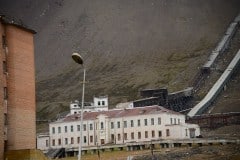We’re in Balakovo, another good sized city on the banks of the Volga. The ride today was through large fields of crops – so we have left the wild grasslands of the southern Volga catchment and as we move north, the soils are supporting large scale commercial cropping. But one of Balakovo’s claims to fame – the one that caught my attention – is that it’s the birthplace of the world’s first caterpillar tractor.
It was self-taught inventor of the late 19th century, Fedor Abramovich Blinov who made a breakthrough in the field of heavy working equipment. He constructed a “carriage” on a crawler track, resembling a railway carriage with a wooden body. The “endless rails” were ironcaps locked into a ring, assembled from individual metal bands flexibly connected to each other. The car had 4 support wheels and 4 leading sprockets – the most important vehicle nodes. The tracked tractor quickly became known and popular among the masses. He obtained the patent in 1879.
Like so much between the US and Russia, this history is somewhat at odds with the American version of where caterpillar tractors came from. The US version is that around 1906, seeking for a way to improve the mobility and traction of his company’s steam tractors, Benjamin Holt of Stockton, California replaced the wheels with wooden tracks bolted to chains. The tractor ran on continuous metal-belted tracks and the tracks kept the heavy vehicle from sinking in mud or dirt. The innovation worked so well that one bystander was said to have remarked that the machine crawled along much like a caterpillar. Holt agreed, and dubbed his new machine “Caterpillar,” a name he eventually trademarked in 1910.
Take you’re pick, they’re both pretty cool inventions.











































































































































































































































































































































































































































































































Comments are closed.